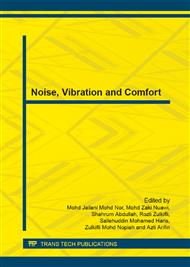p.3
p.9
p.14
p.20
p.25
p.30
p.35
p.40
Tyre Cavity Coupling Resonance and Countermeasures
Abstract:
This paper aims to investigate the coupling resonance conditions of the tyre, cavity and rim with the attachment of trim layers on the inner surface of tyre to mitigate the resonance effect. In order to validate the mathematical formulation, finite element analysis and experimental modal testing were performed to determine the frequency response function (FRF) for a tyre-wheel assembly with and without the trim layers as well as for separated tyre and rim. It was found that the resonance magnitude has been reduced when the trim layers were added. Couplings of cavity resonance to the tyre and rim were plausible due to the proximity of their resonance frequencies. Trim materials were tested using an impedance tube to suggest the best sound absorbing materials that can be used to mitigate the tyre cavity resonance effect.
Info:
Periodical:
Pages:
3-8
Citation:
Online since:
December 2013
Authors:
Keywords:
Price:
Сopyright:
© 2014 Trans Tech Publications Ltd. All Rights Reserved
Share:
Citation:


